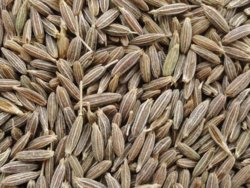Each month we showcase a different spice. I'll be writing up some information about the spice and its over to you to come up with your tips, tricks or recipes using the spice. There is a prize for the most interesting idea or recipe (to be posted anywhere in the world, customs permitting). Just add your ideas to this thread or if you have a recipe, then post it as a new thread and tag it ‘Cumin' and 'spice challenge'. So, as you already realised, this month, the featured spice is Cumin!
Deadline for entries midday Weds 1st November. 2017 (BST)

Cumin - the Info:
Cultivation
Cumin seeds are the small, crescent-shaped seeds of a plant called Cuminum cyminum, a small herbaceous plaint of the parsley family. The plant is native to Eastern Mediterranean countries and Egypt but is also cultivated in Morocco, Iran, Turkey, India, China and the Americas. Harvesting takes place 4 months after planting. The small boat shaped seed has nine ridges and is brownish yellow in colour. There is also a variety of cumin known as black cumin which grows mainly in Iran.
Aroma and flavour
Cumin has pungent spicy aroma with a slightly bitter taste. The pungency and bitterness are more noticeable if you bite into raw seeds. Fortunately they are transformed by cooking. Roasted and crushed, they release nutty lemon notes. Black cumin seeds are smaller are somewhat sweeter in taste and have a slightly smokey flavour.
Culinary use
Cumin is used extensively in Indian, Middle Eastern, North African and Mexican cooking. It is an essential ingredient in most curry powders and many curry pastes and in garam masala. It is often used in spicy Mexican foods such as chile con carne, casseroled pork and enchiladas with chilli sauce. In the Middle East, it is a familiar spice for fish dishes, grills and stews and flavours couscous, steamed over meat and vegetables, the national dish of Morocco.
In Europe, cumin flavours certain Portuguese sausages, and is used to spice cheese, especially Dutch Leyden and German Munster, and burned with woods to smoke cheeses and meats. It is also a pickling ingredient for cabbage and Sauerkraut, and is used in chutneys. Cumin also features as a pickling spice in Scandinavian cooking. It is also used in many sweet recipes such as milky rice and custard like desserts from India as well as in baked goods including bread and cakes.
Cumin is also used in drinks; Zeera pani is a refreshing and appetising Indian drink made from cumin and tamarind water. Cumin together with caraway flavours Kummel, the famous German liqueur.
Now its over to you. How do you use cumin? Tell us your ideas, tips and recipes for using cumin. Deadline for entries is midday (GMT) 1st Nov. 2017.
Sources: Cooking with Herbs and Spices, Hermes House; The Favour Thesaurus, Niki Segnit; http://theepicentre.com/spice/cumin/
Deadline for entries midday Weds 1st November. 2017 (BST)

Cumin - the Info:
Cultivation
Cumin seeds are the small, crescent-shaped seeds of a plant called Cuminum cyminum, a small herbaceous plaint of the parsley family. The plant is native to Eastern Mediterranean countries and Egypt but is also cultivated in Morocco, Iran, Turkey, India, China and the Americas. Harvesting takes place 4 months after planting. The small boat shaped seed has nine ridges and is brownish yellow in colour. There is also a variety of cumin known as black cumin which grows mainly in Iran.
Aroma and flavour
Cumin has pungent spicy aroma with a slightly bitter taste. The pungency and bitterness are more noticeable if you bite into raw seeds. Fortunately they are transformed by cooking. Roasted and crushed, they release nutty lemon notes. Black cumin seeds are smaller are somewhat sweeter in taste and have a slightly smokey flavour.
Culinary use
Cumin is used extensively in Indian, Middle Eastern, North African and Mexican cooking. It is an essential ingredient in most curry powders and many curry pastes and in garam masala. It is often used in spicy Mexican foods such as chile con carne, casseroled pork and enchiladas with chilli sauce. In the Middle East, it is a familiar spice for fish dishes, grills and stews and flavours couscous, steamed over meat and vegetables, the national dish of Morocco.
In Europe, cumin flavours certain Portuguese sausages, and is used to spice cheese, especially Dutch Leyden and German Munster, and burned with woods to smoke cheeses and meats. It is also a pickling ingredient for cabbage and Sauerkraut, and is used in chutneys. Cumin also features as a pickling spice in Scandinavian cooking. It is also used in many sweet recipes such as milky rice and custard like desserts from India as well as in baked goods including bread and cakes.
Cumin is also used in drinks; Zeera pani is a refreshing and appetising Indian drink made from cumin and tamarind water. Cumin together with caraway flavours Kummel, the famous German liqueur.
Now its over to you. How do you use cumin? Tell us your ideas, tips and recipes for using cumin. Deadline for entries is midday (GMT) 1st Nov. 2017.
Sources: Cooking with Herbs and Spices, Hermes House; The Favour Thesaurus, Niki Segnit; http://theepicentre.com/spice/cumin/
Last edited:


